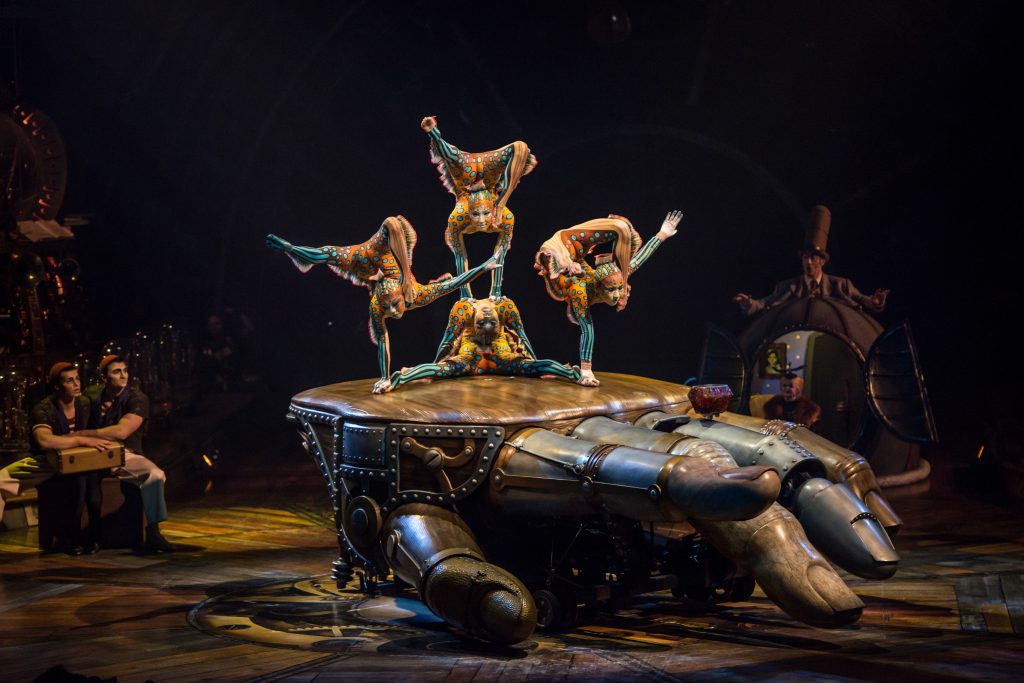Kurios: Cabinet of Curiosities runs April 14-July 17 at Under the Big Top, Ontario Place, in Toronto
In Cirque du Soleil’s Kurios: Cabinet of Curiosities, time has stopped in the 19th century. The set is arranged with phonographs, bell jars and Edison bulbs, and a large metal arch downstage gestures to the heyday of the Industrial Revolution. Or rather, time hasn’t stopped but diverged into a steampunk-inspired retro-future, with rudimentary robots and infinite technological possibility. A clock cranks out the minutes as audience members stream into the grand marquee, and when it hits 11:11 — that loaded number of supernatural opportunity — the show begins.
The world of Kurios, which is written and directed by Michel Laprise, is thoroughly conceptualized. A dreamer and inventor, the Seeker is visited by people from an imaginary realm, the (unimaginatively named) Curiosistanians who help reveal hidden wonders all around him.
Among the Curiosistanians are a number of character artists, including Mr. Microcosmos, the rotund leader and an embodiment of technological advancement; Mini Lili, Mr. Microcosmos’s unconscious and creative side, who lives in his gigantic steel belly; Nico the Accordion Man, a shy handyman; and Klara the Telegraph of the Invisible, with her antenna-like hoop skirt.

Each act is designed around part of the Seeker’s curio cabinet, as unique objects or artifacts in his collection come to life. All of this isn’t immediately apparent from just watching Kurios, but the stuffed narrative conceit and character stories aren’t entirely essential to the production. The general premise alone is an evocative setting for circus that is truly mind-expanding.
Kurios shines when it marries the show’s primary theme of inventiveness with production creativity. Anne Weissbecker starts her aerial act by bicycling around the stage before being gracefully lifted, bike and all, into the air. The smoothness of her movement as she manoeuvres the unwieldy object — grasping a wheel in each hand and twirling quickly, hooking her leg through a spoke to dangle and extend, inverting the bike and riding it upside down — is remarkable.
In a later act, which resembles a Victorian spiritualist gathering, Andrii Bondarenko chases a levitating chandelier by stacking chairs on a dining table and performing an astonishing hand-balance routine. Suddenly a parallel universe appears above the stage: a mirror scene, with guests seated around a table but upside down and rigged from the top of the tent. The chair-balancing act grows taller, while chairs are similarly stacked “down” from the doppelgänger group on the ceiling. Climbing higher, Bondarenko is masterful as he shifts his body into new shapes while balancing on one hand and finally clambering atop the chandelier itself as he meets his double mid-air. I’ve never seen anything like it.
Some sections are less innovative and fit maybe too comfortably with Kurios’s dated inspiration. An aerial straps act based on the premise of conjoined twins unnecessarily recalls a time when certain groups of people — often those with disabilities — were treated as curios or “oddities.” And a comedic act that involves bringing a female audience member onstage for a failed seduction feels misplaced and would have fallen flat were it not for Facundo Gimenez’s committed physical comedy.
But by and large, Kurios is full of showstopping performances. In a mesmerizing contortion act, four artists embodying electric eels mount a giant mechanical hand (a lovely piece by set and props designer Stéphane Roy). The contained platform brilliantly emphasizes the rapidity and intricacy of the choreography: the fluid bends, writhing limbs and pyramids are all executed shockingly fast, in seemingly luminescent blue and orange bodysuits that coil and move as one organism. At one moment, the contortionists, balancing on their hands, enter a deep back bend, their legs flung over their heads, and feet sharpened to a menacing point, evoking the beauty and danger of the deepsea creatures.

There are too many highlights to name each, but also worth mentioning is an acrobatic scene that uses a taut net stretched across the stage to send artists soaring to the top of the tent, and James Gonzalez Correa’s Aviator, who arrives on a primitive flying machine and performs, with bravado, a rola bola balancing act on the suspended and swinging platform.
Kurios is fully realized, meticulously designed from the set and costumes to the choreography and catchy live music. For a show that encourages us to remain open to the imaginative potential just beyond sight or understanding, it asks very little of its audience to meet it there. With Kurios, you don’t have to look too hard to find something extraordinary.
Tagged:






